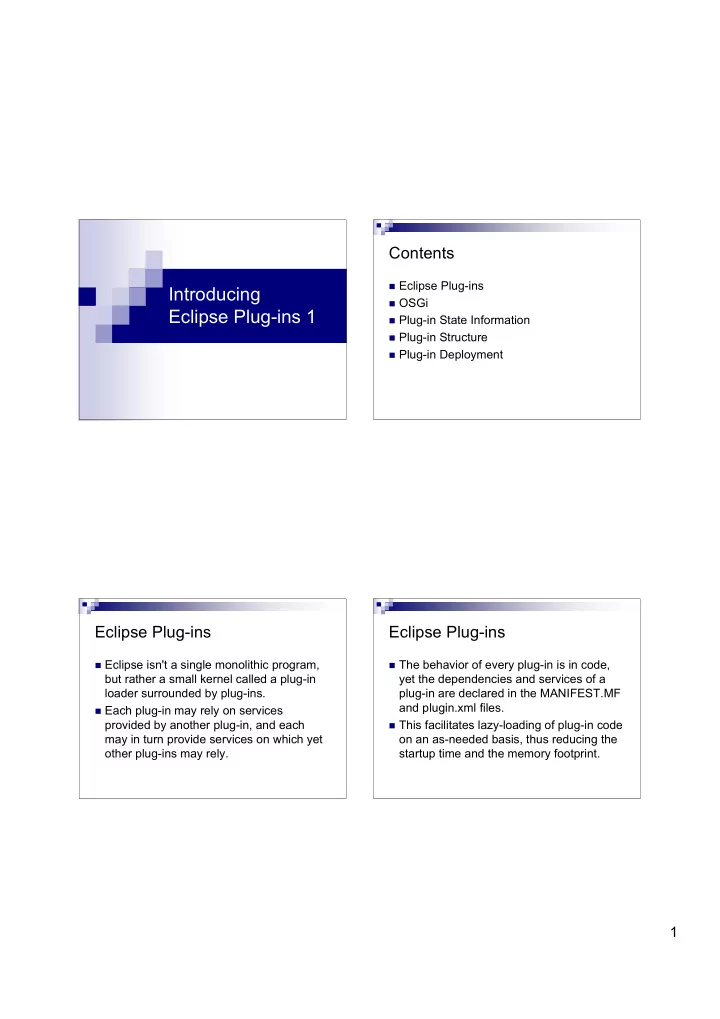

Contents Eclipse Plug-ins Introducing OSGi Eclipse Plug-ins 1 Plug-in State Information Plug-in Structure Plug-in Deployment Eclipse Plug-ins Eclipse Plug-ins Eclipse isn't a single monolithic program, The behavior of every plug-in is in code, but rather a small kernel called a plug-in yet the dependencies and services of a loader surrounded by plug-ins. plug-in are declared in the MANIFEST.MF and plugin.xml files. Each plug-in may rely on services provided by another plug-in, and each This facilitates lazy-loading of plug-in code may in turn provide services on which yet on an as-needed basis, thus reducing the other plug-ins may rely. startup time and the memory footprint. 1
Eclipse Plug-ins OSGi Eclipse originally used a home-grown runtime On startup, the plug-in loader scans the model/mechanism that was designed and MANIFEST.MF and plugin.xml files for implemented specifically for Eclipse. each plug-in and then builds a structure This was good because it was highly optimized containing this information. But, until and tailored to Eclipse. required, it doesn’t load all the code from a But less than optimal because having a unique plug-in. runtime mechanism prevented reusing the work done in other areas (e.g., OSGi, Avalon, JMX, etc.). OSGi Plug-in State Information As of Eclipse 3.0, a new runtime layer was introduced The plug-in state information located in the based upon technology from the OSGi Alliance workspace directory hierarchy is (www.osgi.org). associated only with that workspace, yet It has a strong specification, a good component model, supports dynamic behaviour, and is reasonably similar to the Eclipse IDE, its plug-ins, the plug-in the original Eclipse runtime. static resources and plug-in configuration With each new release of Eclipse, the Eclipse runtime API and implementation (e.g. "plug-ins") continues to files are shared by multiple workspaces. align itself more and more closely with the OSGi runtime model (e.g. "bundles"). 2
Plug-in Structure Plug-in Structure The HelloPlugin plug-in directory (or JAR helloplugin.jar: A file containing the actual file) contains files similar to a typical plug- Java classes comprising the plug-in. in, including *.jar files containing code, Typically, the JAR file is named for the last various images used by the plug-in, and segment in the plug-in's identifier, but it the plug-in manifest. could have any name, as long as that name is declared in the META- List of files: helloplugin.jar, icons, META- INF/MANIFEST.MF file. INF/MANIFEST.MF, plugin.xml. Plug-in Structure Plug-in Structure icons: Image files are typically placed in an META-INF/MANIFEST.MF: A file icons or images subdirectory and describing the runtime aspects of the plug- referenced in the plugin.xml and by the in such as identifier, version, and plug-in plug-in's various classes. Image files and dependencies. other static resource files that are shipped plugin.xml: A file in XML format describing as part of the plug-in can be accessed extensions and extension points. using methods in the plug-in class. 3
Plug-in Deployment The plug-in directory must be located in the plugins directory as a sibling to all the other Eclipse plug-ins. As of Eclipse 3.1, the plug-in can be delivered as a single JAR file containing the same files as a plug-in directory. 4
Recommend
More recommend